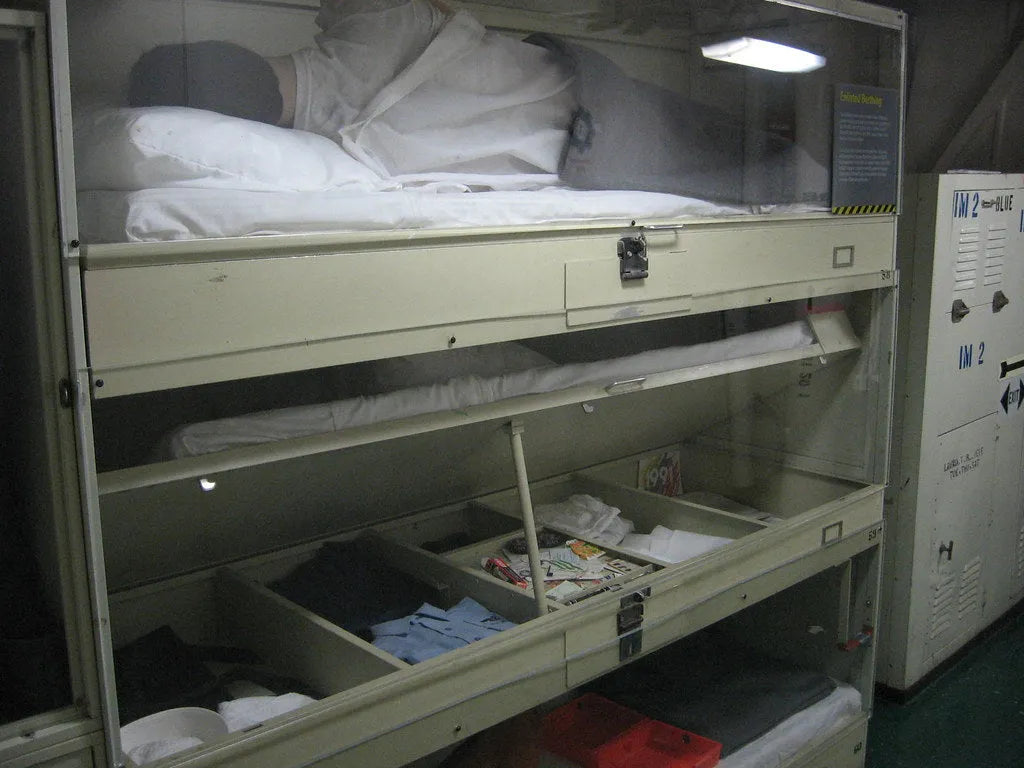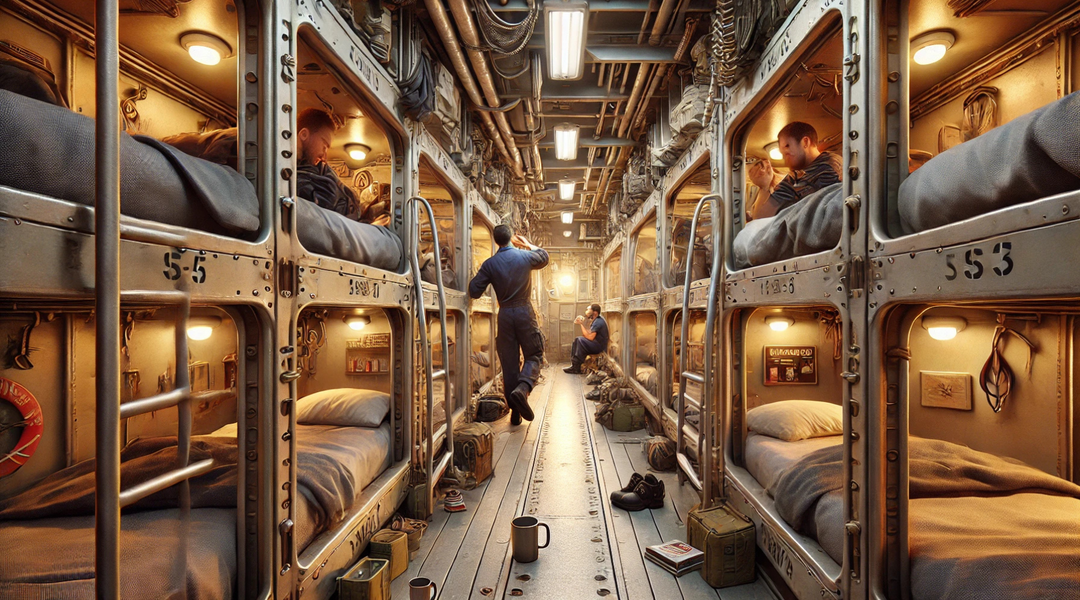What Size Bed is a Navy Rack?

A Navy rack is a unique and essential piece of furniture found on naval vessels that serve as sleeping quarters for the enlisted personnel. These racks are often a subject of curiosity for those who have never served in the Navy, as they differ significantly from the typical beds one would find on land.
In this article, we will explore what a Navy rack is, its dimensions, and how to make it more comfortable for the sailors who rely on it for rest during their demanding duties. We will also delve into the importance of Navy rack curtains and sheets, offering tips on how to choose the best bedding. By the end of this article, you'll have a better understanding of Navy racks and how to improve their comfort and functionality.
What is a Navy Rack?
A Navy rack, also known as a berthing or bunk, is the primary sleeping accommodation for enlisted sailors aboard naval vessels, including aircraft carriers, destroyers, submarines, and other ships. These racks are designed to maximize the use of limited space on naval vessels while providing sailors with a place to rest and sleep during their often long and demanding deployments at sea.
Navy racks come in various sizes and configurations, depending on the type of ship and its specific layout. The most common rack sizes are "single racks" and "double racks." Single racks are designed for individual use and measure approximately 6.5 feet in length, 30 inches in width, and 5.5 feet in height. On the other hand, double racks are designed to accommodate two sailors and are slightly larger, measuring around 6.5 feet in length, 42 inches in width, and 5.5 feet in height.
The design and construction of Navy racks prioritize space efficiency. They are typically stacked in multiple tiers, with narrow passageways between them for access. This arrangement allows naval vessels to maximize the use of available space, as ships must accommodate a large crew and various equipment.
While Navy racks are functional and space-saving, they can be quite Spartan and uncomfortable, making it essential for sailors to find ways to improve their sleeping conditions.
Tips to Help Make Your Navy Rack More Comfortable And Efficient
Here are some tips to help you to optimize the comfort and efficiency of your navy rack.
- Personalizing Your Space: To make your Navy rack more comfortable, consider adding personal touches. While space is limited, you can bring small items like family photos, a favorite book, or a soft pillow to make your rack feel more like home.
- Mattress Toppers: Navy rack mattresses are usually thin and firm to save space. Consider investing in a comfortable mattress topper or memory foam pad to add cushioning and make your sleeping surface more inviting.
- Organizational Accessories: Navy racks have storage compartments for personal belongings, and using dividers and organizers can help keep your space tidy. This not only makes your area more comfortable but also more functional.
- Earplugs and Eye Masks: Life aboard a naval vessel can be noisy and well-lit at all hours. Earplugs and eye masks can help you sleep better by blocking out unwanted noise and light.
- Stay Hydrated and Well-Nourished: Proper nutrition and hydration are essential for restful sleep. Avoid consuming caffeine or heavy meals close to bedtime, and be mindful of your dietary choices.
Navy Rack Curtains and Why They Are Important
Custom navy rack curtains play a vital role in ensuring the privacy, comfort, and functionality of the sleeping quarters on a naval vessel. Here's why they are essential:
- Privacy: Navy racks are often stacked in tight quarters, and maintaining privacy is challenging. Curtains offer sailors a degree of personal space and a sense of privacy during their off-duty hours. This privacy is crucial for unwinding, changing clothes, and personal grooming.
- Light Control: Naval vessels operate around the clock, which means that sleeping quarters can be well-lit at any time. Navy rack curtains help block out ambient light, allowing sailors to sleep during daylight hours or when overhead lights are on.
- Noise Dampening: Navy ships can be noisy places, with machinery, engines, and crew members working around the clock. Curtains can help dampen noise, creating a more conducive environment for rest.
- Division of Space: On ships with open berthing areas, curtains can help separate sleeping spaces and provide a sense of individuality for each sailor.
- Added Comfort: Beyond privacy and practicality, curtains also contribute to the overall comfort of the Navy rack. They add a personal touch to the otherwise spartan environment and help create a cozy sleeping nook.
Organizing your Navy Rack Using Custom Navy Rack Curtains
Custom curtains not only add a touch of individuality but also serve a functional purpose in terms of privacy, light control, and organization. Here's how you can organize your rack space using custom Navy rack curtains:
1. Measure Your Rack
Start by measuring the dimensions of your Navy rack. Ensure you take accurate measurements of the width, height, and length of the space where you plan to hang the curtains. This will help you order or make curtains that fit perfectly.
2. Choose the Right Fabric
Select a fabric that suits your personal style and preferences. Ideally, choose a fabric that is durable, easy to clean, and offers some degree of privacy. Cotton, polyester, or a blend of these materials can work well. Avoid fabrics that are too sheer, as they may not provide the desired privacy.
3. Select a Color or Pattern
Decide on the color or pattern for your custom curtains. This is where you can add a personal touch to your sleeping space. You can choose a color that matches your bedding or go with a pattern that reflects your personality or interests. Darker colors may help block out light more effectively.
4. Hanging Mechanism
There are various ways to hang custom curtains in your Navy rack. You can use curtain rods, tension rods, or hooks. Make sure to choose a method that is secure and doesn't damage the ship's infrastructure. Check with your ship's regulations or guidelines to ensure you're using an approved hanging method.
5. Curtain Length
When measuring the length of your curtains, make sure they reach from the ceiling to the floor. This provides maximum privacy and light control. You can also choose to have the curtains reach only to the height of the mattress for a cozier feel.
6. Securing the Curtains
Ensure that your curtains are secured in a way that prevents them from swaying or falling during rough seas or sudden ship movements. You might need to use clips, ties, or Velcro straps to keep the curtains in place.
7. Maintenance and Cleaning
Navy ships can be dusty and exposed to various elements. Make sure your curtains are easy to remove for washing or cleaning. Choose a fabric that can be machine-washed or wiped down if necessary.
8. Personal Touch
Consider adding personal touches to your curtains. You can sew or attach pockets for storage, such as small shelves for books or personal items. This will help you keep your space organized and functional.
9. Privacy Panels
If you're sharing a berthing space with other sailors, you can add separate privacy panels that can be pulled closed when you need personal space or opened when you want to interact with your neighbors.
10. Safety and Compliance
Always ensure that your custom Navy rack curtains comply with safety regulations and guidelines on your ship. They should not obstruct emergency access, ventilation, or any safety equipment.
By customizing your Navy rack with curtains, you not only create a more comfortable and personalized sleeping space but also a more organized and functional one. Your custom curtains can offer privacy, block out light and noise, and serve as storage solutions, helping you make the most of your limited living space aboard a naval vessel. Remember to check with your ship's regulations and guidelines to ensure that your curtain setup is in compliance with safety and operational requirements.
Navy Rack Sheets: Why You Need Them and How to Choose the Best
Sheets are an integral part of creating a comfortable and hygienic sleeping environment in a Navy rack. Here's why you need them and how to select the best ones:
- Hygiene and Cleanliness: Navy rack mattresses are often made of vinyl or other easy-to-clean materials. However, to maintain a high level of hygiene, it's essential to use fitted sheets. These sheets can be easily removed, laundered, and replaced, ensuring a clean and fresh sleeping surface.
- Comfort: Navy rack mattresses are not known for their plushness. Adding quality sheets can significantly improve the comfort of the sleeping surface. Look for sheets made from soft and breathable materials, such as cotton, that will provide a more comfortable night's sleep.
- Size and Fit: Navy rack mattresses come in standard sizes, and it's crucial to choose sheets that fit snugly. Fitted sheets designed for Navy racks are widely available and ensure a proper fit without excess fabric.
- Durability: Navy racks endure a fair amount of wear and tear. Choose sheets that are durable and can withstand frequent washing. Look for high thread count sheets for a more robust and long-lasting option.
- Breathability: Given the limited ventilation in Navy racks, it's important to choose sheets that allow for adequate airflow to prevent moisture buildup and promote a more comfortable sleeping environment.
Navy Rack - What Size Bed Is It?
The term "Navy rack" is a colloquial expression commonly used to describe the sleeping accommodations on board a ship in the United States Navy. Navy racks are essentially the equivalent of beds on land, but they are designed to optimize space and efficiency on a ship, where space is at a premium. To understand the size of a Navy rack, one must consider the dimensions and features that make it unique.
Navy racks come in various sizes, and the specific size of a rack can vary from one class of ship to another. However, there are some standard dimensions and characteristics that are commonly associated with Navy racks. These beds are designed to accommodate the unique needs and constraints of life at sea, providing sailors with a place to rest and sleep during their time on the ship.
Typically, a Navy rack is designed to be compact and space-efficient. The standard size of a Navy rack is about 77 inches in length, which is slightly shorter than a twin-sized bed commonly found on land. This reduced length allows for more racks to fit within the confined spaces of a ship's berthing compartments. The width of a Navy rack is typically around 27 inches, making it narrower than a standard twin bed. This width is just wide enough to comfortably accommodate one person.
One of the defining features of Navy racks is that they are stackable or "hinged." Each rack is hinged at the head and foot, allowing it to be folded up during the day to create more open floor space in the berthing area. This foldable design is essential for maximizing space on a ship, as it enables sailors to move around more freely when they are not sleeping. When it's time to sleep, the rack can be folded down to create a secure and private sleeping space.
The height of a Navy rack can vary depending on the ship's class and the specific design of the berthing compartment. In some cases, the upper rack may be positioned relatively close to the ceiling of the compartment, while the lower rack is closer to the deck. This arrangement allows for a tiered sleeping configuration that further optimizes space. The upper rack is accessed using a small ladder or built-in steps.
Additionally, Navy racks are equipped with various features to enhance the comfort and privacy of the sailor using them. These features may include a privacy curtain that can be drawn closed, a reading light, and a small storage area for personal items. The privacy curtain is particularly important as it provides a sense of personal space and helps block out ambient light and noise, making it easier for sailors to rest and sleep.
The Navy pays careful attention to the design and maintenance of racks to ensure the well-being of its personnel. The mattresses used in Navy racks are specially designed to provide comfort and support. In addition, bedding and linens are provided to sailors, and these are regularly cleaned and replaced to maintain hygiene and comfort.
While Navy racks are space-efficient and functional, they are not known for their luxurious comfort. Sailors often have to adapt to the unique challenges of sleeping at sea, where the ship's motion can lead to unpredictable and uneven sleeping conditions. Despite these challenges, the Navy rack serves its purpose, allowing sailors to get the rest they need while on duty, and it exemplifies the Navy's commitment to maximizing space and resources on its vessels.
Summary
In conclusion, the size of a Navy rack is typically about 77 inches in length and 27 inches in width, making it slightly shorter and narrower than a standard twin bed. These racks are designed to be space-efficient and are equipped with features to enhance the comfort and privacy of sailors. Their foldable design, combined with other space-saving measures, allows multiple racks to fit within the confined spaces of a ship's berthing compartment. While Navy racks may not offer the same level of comfort as a land-based bed, they are an essential part of life at sea in the United States Navy, providing sailors with a place to rest and sleep during their deployments.







Leave a comment